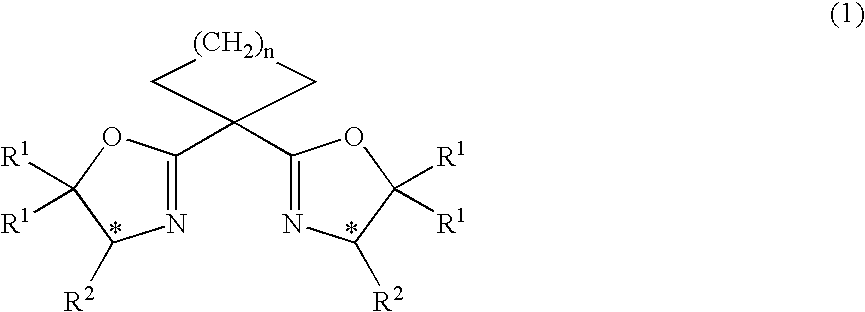Process for producing optically active cyclopropane compound and asymmetric copper complex for use in the same
a technology of cyclopropane compound and asymmetric copper complex, which is applied in the direction of organic compound/hydride/coordination complex catalyst, organic compound without c-metal linkage, physical/chemical process catalyst, etc., can solve the problem of insufficient methods
- Summary
- Abstract
- Description
- Claims
- Application Information
AI Technical Summary
Benefits of technology
Problems solved by technology
Method used
Image
Examples
example 1
[0070] In a 50 mL Schlenk tube purged with nitrogen, 12.9 mg (0.050 mmol) of copper(I) trifluoromethanesulfonate toluene complex and 5 mL of dichloroethane were mixed and 16.1 mg (0.055 mmol) of 1,1-bis[2-[(4S)-(tert-butyl)-oxazoline]]cyclopropane was added into the cloudy mixture obtained and the resulting mixture was stirred at room temperature for 10 minutes to obtain the yellow homogenous solution containing the asymmetric copper complex. After that, 2.56 g (20 mmol) of 3-methyl-2-butenyl acetate was added to the solution and the inner temperature was adjusted to 0° C. 6 mL of the dichloroethane solution containing 1.14 g (10 mmol) of ethyl diazoacetate was added dropwise thereto over 2 hours and the resulting mixture was stirred at the same temperature for 30 minutes to effect reaction and the solution containing ethyl 3,3-dimethyl-2-(acetoxymethyl)cyclopropanecarboxylate was obtained.
[0071] Yield: 54% (based on ethyl diazoacetate) trans-isomer / cis-isomer ratio: 84 / 16
[0072] H...
example 2
[0076] Into a 50 mL Schlenk tube purged with nitrogen, 6.47 mg (0.025 mmol) of copper(I) trifluoromethanesulfonate toluene complex, 8.00 mg (0.027 mmol) of 1,1-bis[2-[(4S)-(tert-butyl)-oxazoline]]cyclopropane and 5 mL of dichloroethane were added and the resulting mixture was stirred at room temperature for 10 minutes to obtain the solution containing the asymmetric copper complex. After that, 8.81 g (50 mmol) of 3-methyl-2-butenyl benzyl ether was added to the solution and the inner temperature was adjusted to 0°0 C. 10 mL of the dichloroethane solution containing 2.85 g (25 mmol) of ethyl diazoacetate was added dropwise thereto over 2 hours and the resulting mixture was stirred at the same temperature for 30 minutes to effect reaction and the solution containing ethyl 3,3-dimethyl-2-(benzyloxymethyl)cyclopropanecarboxylate was obtained.
[0077] Yield: 82% (based on ethyl diazoacetate) trans-isomer / cis-isomer ratio: 94 / 6
[0078] Herein, the trans-isomer means the compound having the ...
example 3
[0082] Into a 50 mL Schlenk tube purged with nitrogen, 12.9 mg (0.050 mmol) of copper(I) trifluoromethanesulfonate toluene complex, 16.1 mg (0.055 mmol) of 1,1-bis[2-[(4S)-(tert-butyl)-oxazoline]]cyclopropane and 5 mL of dichloroethane were added and the resulting mixture was stirred at room temperature for 10 minutes to obtain the solution containing the asymmetric copper complex. After that, 2.88 g (20 mmol) of isobutenylmethyl methyl carbonate was added to the solution and the inner temperature was adjusted to 0° C. 6 mL of the dichloroethane solution containing 1.14 g (10 mmol) of ethyl diazoacetate was added dropwise thereto over 2 hours and the resulting mixture was stirred at the same temperature for 30 minutes to effect reaction and the solution containing ethyl 3,3-dimethyl-2-(methoxycarbonyloxymethyl)cyclopropanecarboxylate was obtained.
[0083] Yield: 68% (based on ethyl diazoacetate) trans-isomer / cis-isomer ratio: 90 / 10
[0084] Herein, the trans-isomer means the compound h...
PUM
| Property | Measurement | Unit |
|---|---|---|
| temperature | aaaaa | aaaaa |
| reaction temperature | aaaaa | aaaaa |
| reaction temperature | aaaaa | aaaaa |
Abstract
Description
Claims
Application Information
 Login to View More
Login to View More - R&D
- Intellectual Property
- Life Sciences
- Materials
- Tech Scout
- Unparalleled Data Quality
- Higher Quality Content
- 60% Fewer Hallucinations
Browse by: Latest US Patents, China's latest patents, Technical Efficacy Thesaurus, Application Domain, Technology Topic, Popular Technical Reports.
© 2025 PatSnap. All rights reserved.Legal|Privacy policy|Modern Slavery Act Transparency Statement|Sitemap|About US| Contact US: help@patsnap.com



